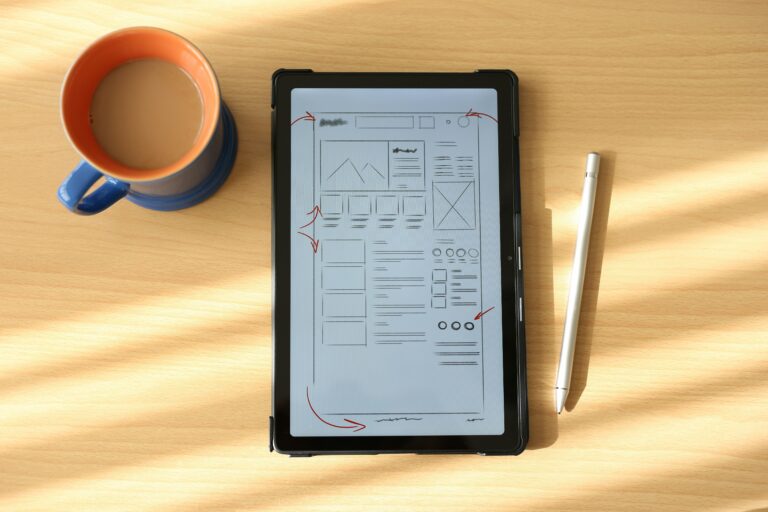Marketing Consultant
27 Jun, 2025
User experience designer
User experience (UX) design is no longer a niche role limited to tech startups or design agencies. Today, companies across every major sector in the UK, from banking and healthcare to education and e-commerce, are investing heavily in digital experiences. As user expectations grow, so does the need for designers on permanent and interim product design and UX contractors who can deliver intuitive, accessible and effective digital products.
If you’re exploring UX as a career path or considering switching from a related field, you might be wondering: is UX design really in demand in the UK? This guide breaks it all down, from salaries and job prospects to skill requirements and long-term stability.
Is UX design in high demand in the UK? (quick answer)
Yes, UX design is in strong demand across the UK in 2025. Businesses are focusing more than ever on user-centred strategies to improve customer retention, accessibility, and overall product value. This shift isn’t just happening in tech, it spans finance, healthcare, education, government services, and even the charity sector.
Companies are hiring for roles like UX designer, UX researcher, product designer, and service designer. With the rise of remote and hybrid work models, opportunities have expanded well beyond London, offering flexibility and access to a wider range of jobs.
From entry-level roles to leadership positions, UX design has become a critical pillar in digital product teams, and the demand is still growing.
UX roles Intelligent People recruits for includes:
What is a UX designer?
A UX (user experience) designer focuses on making digital products easy, intuitive and satisfying to use. They work to understand users’ needs and behaviour, then design experiences that solve real problems in user-friendly ways.
Key responsibilities:
- Conducting user research (surveys, interviews, usability tests)
- Creating wireframes and interactive prototypes
- Collaborating with developers, product managers and UI designers
- Testing and iterating designs based on feedback
- Ensuring products are accessible and inclusive
UX designers use a variety of tools including Figma, Adobe XD, Sketch and Miro, to turn insights into tangible product improvements. While closely related to UI (user interface) design, UX focuses on how a product works and feels, not just how it looks.
Think of UX as the structure and logic of a house, and UI as the paint, furniture and decor.
What is a UX designer’s salary in the UK?
UX design is a well-paid career in the UK, with salaries that reflect both high demand and the strategic value UX brings to businesses.
Average UX designer salaries in 2025:
- Entry-level (0–2 years): £28,000–£40,000
- Mid-level (3–5 years): £40,000–£60,000
- Senior/lead designers: £60,000–£85,000+
- UX managers and heads of UX: £80,000–£100,000+
Salaries tend to be highest in London, though strong wages are also available in regional tech hubs like Birmingham, Manchester, Bristol, Edinburgh, and through remote roles.
Freelancers and contractors can earn £300–£500 per day, especially with niche skills like UX research or service design.
Is it difficult to get a job as a UX designer?
Getting started in UX can be competitive, especially for entry-level roles, but with the right approach, it’s very achievable.
Common challenges:
- Many candidates come from design, psychology, or tech backgrounds, creating a crowded market
- Employers expect a strong UX portfolio
- Real-world experience is often required, even for junior positions
Ways to stand out:
- Build a compelling portfolio with 2–3 case studies that demonstrate your UX process (research, ideation, testing, iteration)
- Learn industry tools like Figma, Miro, and Maze
- Join UX communities such as UXPA UK or local meetups to network and discover opportunities
- Take an accredited course or bootcamp to gain credentials and project experience
- Volunteer or freelance for real projects (nonprofits, startups, or open-source) to build your resume
The first role can be the hardest to land, but once you’re in, upward mobility is strong and the field opens up quickly.
Is UX design a stable career?
UX design offers long-term career stability and growth potential, even in uncertain job markets.
Reasons it’s a stable path:
- Digital transformation continues across all sectors
- User-centric design is now seen as a competitive business advantage
- Accessibility and inclusive design are increasingly regulated and essential
- UX skills are transferable across industries and job types
Career progression:
- Junior UX designer
- Mid-weight/senior UX designer
- Lead designer or UX architect
- UX manager or head of product/design
Many designers also branch into related roles like product design, brand design studios, service design, UX research, or product management. The versatility of UX makes it future-proof and resistant to automation, human empathy, creative problem-solving and understanding user needs remain key differentiators.
Do UX designers need to code?
No, coding is not required for most UX design roles. UX designers focus primarily on research, wireframes, usability and interaction design – not writing code.
That said, understanding code can help:
- Communicate more effectively with developers
- Design solutions that are technically feasible
- Work in cross-functional teams or on more technical products
Knowing basic HTML, CSS, or JavaScript can also be helpful in hybrid roles like UI/UX designer or in smaller companies where job functions overlap.
But for most pure UX roles, employers prioritise user empathy, problem-solving and communication far above coding skills – unless the it is a specific coding role, of course.
What skills and tools do UX designers need in 2025?
As the field matures, UX designers are expected to balance technical competence with soft skills and strategic thinking.
Top skills employers look for:
- User research and testing
- Wireframing and prototyping
- Journey mapping and personas
- Accessibility and inclusive design
- Stakeholder communication
- Design thinking and problem-solving
Tools widely used today:
- Figma – the go-to for interface design and prototyping
- Miro and FigJam – for collaborative mapping and workshops
- Maze and Optimal Workshop – for testing and research
- Notion or Confluence – for documentation and workflow
Soft skills like empathy, storytelling, and collaboration are just as important as technical knowledge. UX is ultimately about creating solutions for real people, and that requires strong interpersonal insight.
How to get started in UX design in the UK
You don’t need a traditional university degree to break into UX design. Many successful UX professionals come from fields like psychology, teaching, graphic design, marketing, or development.
Education and training options:
- Bootcamps: General Assembly, CareerFoundry, UX Design Institute
- University degrees: Some UK programs offer BAs and MAs in digital design or human-computer interaction
- Self-paced online courses: Coursera (Google UX Certificate), Interaction Design Foundation
How to build a strong portfolio:
- Tackle a redesign of an app or website you use
- Create UX case studies that show your thinking process
- Volunteer for a nonprofit or small business to get real-world experience
- Document your process, research, ideation, wireframes, feedback, final design
Entry points into the industry:
- Internships and apprenticeships at design agencies or product companies
- Junior UX roles in startups or digital teams
- Freelancing to build experience and confidence
Once you’ve built a solid portfolio and gained some project experience, you’ll be well-positioned to land a junior role, and from there, the possibilities grow.
Final thoughts: is UX design a good career choice in the UK?
UX design is more than just a job, it’s a creative, strategic, and people-focused career that’s in high demand and growing steadily in the UK.
Whether you’re a career changer, a recent graduate, or a self-taught designer, there are clear paths into the field. With competitive salaries, diverse job options, and long-term stability, UX offers one of the most rewarding careers in the digital space.
If you enjoy solving problems, improving experiences, and working at the intersection of design and technology, UX design is an excellent path to consider, and now is the perfect time to start.
Key takeaways
- UX design is in high demand in the UK in 2025, especially across tech, finance, healthcare, and e-commerce
- Salaries are strong, with junior roles starting at £28k and senior roles reaching £85k+
- Breaking in takes effort, but a great portfolio and hands-on experience can open doors
- Coding isn’t required, but understanding development basics is helpful
- UX is a future-proof career, with opportunities for growth, specialization, and impact
Intelligent People are specialist UX recruiters. If you’re looking for your next career move, visit our live jobs. Or, if you’re looking to fill a UX role, head over to our I need to hire page.




